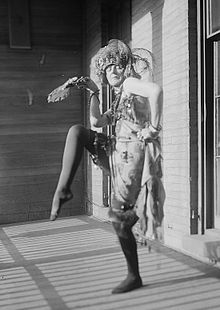Flapper women in the Roaring Twenties
This week as our class pours over The Waste Land (1922) and Spring and All (1923), we are experiencing but a small amount of modernism in the Roaring Twenties. After losing our worldly innocence in World War I, the United States, along with Europe, experienced a massive growth in electricity, automobiles, telephones, motion pictures, and industrialism. Women, especially, saw what it meant to be a modern woman by replacing full skirts for shorter flappy ones after they gained their right for suffrage and picked up magazines instead of children. Our country, more embolden than ever took literature to new heights in literary scandal, including D. H. Lawrence’s Lady Chatterley’s Lover (1928) because of the novel’s explicit sexual discussion.
The Little Review, 1925
In the midst of the cultural acceptance of women, Margaret Anderson founded, edited, and published The Little Review, which initially became an anarchist and imagist art and writing magazine. An ironic description seeing as William Carlos Williams was firmly against the imagism his contemporaries Ezra Pound and T. S. Eliot were known for, but was him known for experimentalism. (Pound became Anderson’s foreign editor in 1917.) Along with many other supporters, Anderson received many contributions from Pound and Eliot. Later The Little Review became cutting-edge in its celebration of its fresh infusion of international experimentalism. Perhaps The Little Review’s greatest and boldest achievement was the serialized publication of Ulysses by James Joyce (1922), which later resulted in a grand literary upheaval that only resulted in fines and fingerprinting for Anderson and her lover-partner Jane Heap, although the Obscenity Trial of 1921 made HUGE headlines. The articulated purpose of Anderson’s Review was to create a new type of criticism because “criticism as an art has not flourished in this country” and in Anderson’s mind to criticize meant to “appreciate” (“Announcement” 1914 in The Little Review).

The Little Review, covering featuring “Ulysses” by James Joyce
I found it unsettling to simply categorize this woman, Elsa von Freytag-Loringhoven, so instead, a list of her achievements…

Baroness Elsa von Freytag Loringhoven – the “living piece of art”
Baroness Elsa von Freytag-Loringhoven – German-born, female sound poetry pioneer, artist, actress, “living piece of art” known for scatological aesthetics, collaborator, expatriate, avant-garde, and “the original dada” (Anderson). Freytag-Loringhoven was the most popular poet in The Little Review, and was published alongside Williams, Robert Reiss, H. D., Mina Loy, Gertrude Stein, and Sherwood Anderson, and like Joyce, a “criminal” responsible for some of the strongest attacks on the Review’s subversive character. However, considering the literary and artistic material of this decade of modernism, the Roaring Twenties were a time to turn heads, scandal and shock-value only furthered Anderson’s appreciation of art and “Making No Compromise with the Public Taste” (Irene Gammel, The Little Review and Its Dade Fuse: 1918 to 1921, 2002).

You try to cover a lot of ground in this archival post–you might have focused more narrowly on just a few issues of The Little Review from around this time. At first, I thought this was a chronos post! The info on Freytag-Loringhoven is fascinating…